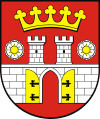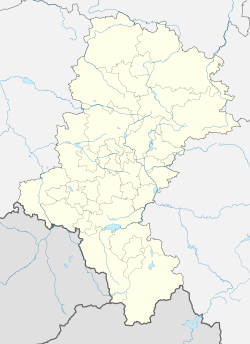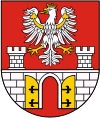Będzin
Będzin [ˈbɛnd͡ʑin] (![]()
Będzin | |
|---|---|
 Będzin Castle | |
 Flag  Coat of arms | |
| Motto(s): Civitas Regi Bendzinensis | |
 Będzin  Będzin | |
| Coordinates: 50°20′N 19°7′E | |
| Country | |
| Voivodeship | |
| County | Będzin |
| Gmina | Będzin (urban gmina) |
| Established | 9th century |
| Town rights | 1358 |
| Government | |
| • Mayor | Łukasz Komoniewski |
| Area | |
| • Total | 37.08 km2 (14.32 sq mi) |
| Highest elevation | 382 m (1,253 ft) |
| Lowest elevation | 260 m (850 ft) |
| Population (2019-06-30[1]) | |
| • Total | 56,624 |
| • Density | 1,500/km2 (4,000/sq mi) |
| Time zone | UTC+1 (CET) |
| • Summer (DST) | UTC+2 (CEST) |
| Postal code | 42-500 |
| Area code(s) | +48 32 |
| Car plates | SBE |
| Website | http://www.bedzin.pl |
It has been situated in the Silesian Voivodeship since its formation in 1999. Before 1999, it was located in Katowice Voivodeship (1975–1999). Będzin is one of the cities of the 2.7 million person conurbation - Katowice urban area and within a greater Silesian metropolitan area populated by about 5,294,000 people.[2] The population of the city itself is 58,639 (2008).[3]
Będzin is located 12 km (7 mi) from Katowice and 4 km (2 mi) from the center of Sosnowiec. Together with Sosnowiec, Dąbrowa Górnicza, Czeladź, Wojkowice, Sławków and Siewierz it makes Zagłębie Dąbrowskie, a highly industrialized and densely populated part of western Lesser Poland. Będzin borders the cities of Sosnowiec, Dąbrowa Górnicza, Czeladź, Siemianowice Śląskie, and Wojkowice, as well as the village of Psary. The highest point of the town is St. Dorthy Mountain 382 metres (1,253 feet) above sea level, and the area of Będzin is 37.08 square kilometres (14.32 square miles).
Districts
Będzin is divided into eight districts: Grodziec in 1951–1975 was a separate town, Gzichów is part of Będzin since 1915, Ksawera is part of Będzin since 1923, Łagisza in 1967–1973 was a separate town, Małobądz is part of Będzin since 1915, Śródmieście is the historic center, Warpie is part of Będzin since 1923.
Etymology
The name Będzin most probably comes from ancient Polish given name Beda or Bedzan. In the past, the town was also called Banden, Bandin, Bandzien, Bondin, Bandzen, Bandzin, Badzin, Bendzin, and Bendsburg (1939–1945).
History
First mention of the village of Będzin comes from 1301, but a settlement (or a grod) had existed here since the 9th century, guarding ancient trade route from Kiev to Western Europe. In the 1340s, a town was founded here, with King Casimir III the Great building a stone strongpoint. On August 5, 1358, Będzin was incorporated as a town (see German town law), part of Lesser Poland's Kraków Voivodeship.
In the Jagiellonian period Będzin, located on the border between Lesser Poland and Silesia, was a major trade center. In 1565 King Sigismund II Augustus allowed the town to have five markets a week, and in 1589, at Będzin Castle, Polish - Austrian negotiations took place. At that time, a Jewish community already existed here. In 1655, during The Deluge, both town and castle were destroyed by the Swedes, and Będzin did not recover from the destruction for many years. Following the Partitions of Poland, the town was annexed by the Kingdom of Prussia, as New Silesia, and in 1815 it became part of Russian-controlled Congress Poland.
Industrial revolution
In the late 18th century rich deposits of coal were found in the area. In the 19th century, Będzin and its vicinity enjoyed a period of rapid industrialization and urbanization. New settlements and towns were founded, and the region of Zagłębie Dąbrowskie was established in southwestern corner of Congress Poland. In 1858, Będzin got its first rail connection, due to construction of the Warsaw–Vienna railway. The town increased in population and size, when neighboring settlements were annexed by it.
The Będzin Power Station was opened in 1913.
In the Second Polish Republic Będzin was an important center of local administration and industry. New rail station, waterworks, schools and offices were built.
World War II
On September 4, 1939, the Wehrmacht entered Będzin, and within months, the Będzin Ghetto was established by the occupational authority in July 1940. During the occupation, the town’s name was changed to a German form, Bendsburg, and it was part of Upper Silesia Province, as the capital of Landkreis Bendsburg.
During the Second World War the city was the base for a working party (E716) of British and Commonwealth prisoners of war, under the administration of Stalag VIIIB/344 at Łambinowice (then known as Lamsdorf) in Poland. In January 1945, as the Soviet armies resumed their offensive and advanced from the east, the prisoners were marched westward in the so-called Long March or Death March. Many of them died from the bitter cold and exhaustion. The lucky ones got far enough to the west to be liberated by the allied armies after some four months of travelling on foot in appalling conditions. Their sufferings, though severe, pale by comparison to those of the Jews of Będzin (see below).[4]
On January 27, 1945, the town was captured by the Red Army. Subsequently, the castle was rebuilt, now housing the Museum of Zagłębie. New districts with blocks of flats were built and new factories were opened, including the Łagisza Power Station.
Jews in Będzin
Until World War II, Będzin had a vibrant Jewish community. According to the Russian census of 1897, out of the total population of 21,200, Jews constituted 10,800 (around 51% percent).[5] According to the Polish census of 1921 the town had a Jewish community consisting of 17,298 people, or 62.1 percent of its total population.[6] In September 1939, the German Army (Wehrmacht) overran this area, followed by the SS death squads (Einsatzgruppen), who burned the Będzin synagogue and murdered 200 Jewish inhabitants.[7] A Będzin Ghetto was created in 1942. Eventually, in the summer of 1943, most of the Jews in Będzin were deported to the nearby German concentration camp at Auschwitz. Since Będzin was one of the last Polish communities to be liquidated, there are a relatively large number of survivors from there, and an extensive collection of their personal photographs were recovered, offering photographic insight into the pre-war life there.
Transport
Będzin is conveniently located at the intersection of two national roads - the 94th (Zgorzelec - Kraków), and the 86th (Katowice -Warsaw). Katowice International Airport is located 23 km (14 mi) away, at Pyrzowice. The town also is a rail hub, where two connections meet. Będzin has three rail stations (Będzin-Miasto, Będzin and Będzin-Ksawera), and convenient bus and tram connections to neighboring cities. First tram line was opened here in 1928.
Notable people

- Hermann Nunberg (1884–1970), psychoanalyst and neurologist, assistant of Carl Jung, disciple of Sigmund Freud
- Isser (Birencwajg) Be'eri (1901–1958), Director of the Haganah Intelligence Service
- Joshua Prawer (1917–1990), Israeli historian, founder of the crusader studies
- Sam Pivnik (1926–2017), Holocaust survivor; writer of Survivor: Auschwitz, The Death March and My Fight for Freedom
- Rutka Laskier (1929–1943), diarist; Holocaust victim
- Janusz Gajos (born 1939), actor
- Grzegorz Dolniak (1960–2010), politician
- Andrzej Kubica (born 1972), footballer
- Monika Jarosińska (born 1974), actress and singer
Twin towns — sister cities




References and other sources
- "Population. Size and structure and vital statistics in Poland by territorial divison in 2019. As of 30th June". stat.gov.pl. Statistics Poland. 2019-10-15. Retrieved 2020-02-14.
- European Spatial Planning Observation Network (ESPON) "Archived copy". Archived from the original on 2009-07-28. Retrieved 2009-03-28.CS1 maint: archived copy as title (link)
- Powierzchnia i ludność w przekroju terytorialnym w 2008 - Central Statistical Office in Poland ISSN 1505-5507 , 13.08.2008
- Lamsdorf: Stalag VIIIB 344 Prisoner of War Camp 1940–1945 - Home
- Joshua D. Zimmerman, Poles, Jews, and the politics of nationality, Univ of Wisconsin Press, 2004, ISBN 0-299-19464-7, Google Print, p.16
- Jewish Historical Institute community database "Archived copy". Archived from the original on 2012-02-16. Retrieved 2012-02-16.CS1 maint: archived copy as title (link)
- Dissonant Lives: Generations and Violence Through the German Dictatorships By Mary Fulbrook page 176
- "Miasta partnerskie". bedzin.pl (in Polish). Będzin. Retrieved 2020-02-14.
- Weiss, Ann (2005). The Last Album: Eyes from the Ashes of Auschwitz-Birkenau, 2nd ed. Philadelphia: Jewish Publication Society of America. pp. 32–37. ISBN 0-393-01670-6.
- Mary Fulbrook, A Small Town near Auschwitz: Ordinary Nazis and the Holocaust (Oxford University Press, 2012)
External links
| Wikimedia Commons has media related to Będzin. |
- Official web page of the city of Będzin (Polish)
- Jewish Community in Będzin on Virtual Shtetl
- Będzin, Poland at JewishGen
- A Memorial to the Jewish Community of Będzin
- Będzin, Czeladź, Dąbrowa Górnicza, Sławków, Sosnowiec
- http://www.oup.com/us/catalog/general/subject/HistoryOther/MilitaryHistory/WWII/?view=usa&sf=toc&ci=9780199603305
- http://blog.oup.com/2012/08/bedzin-1942-2012-small-town-auschwitz/
